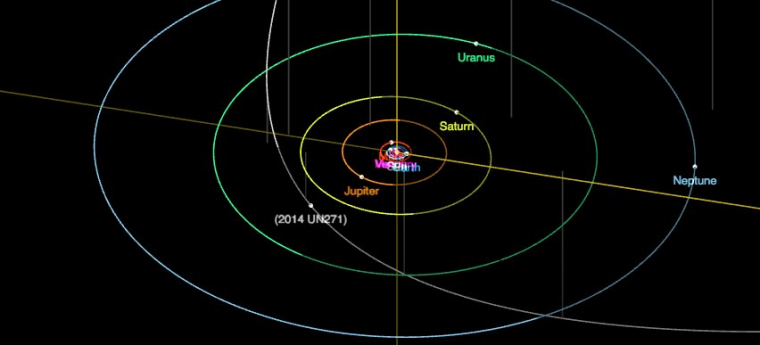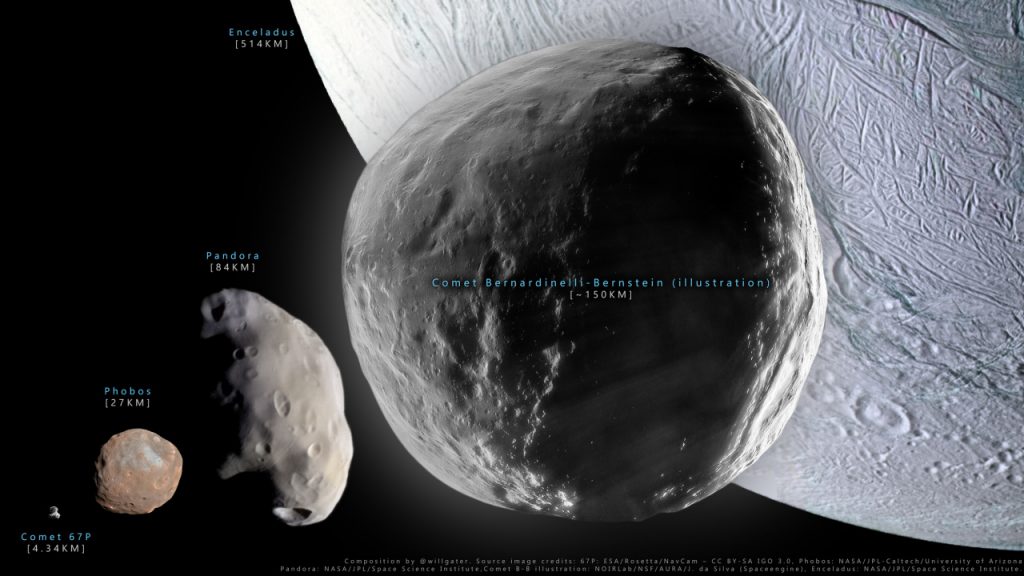Comet Bernardinelli-Bernstein, also known as C/2014 UN271, may be the largest comet ever observed. Scientists estimate that its diameter is 150 km! Moreover, it is supposed to be closer to Earth in 2031.
Compare the size of the newly described comet with other known objects. The smallest is Comet 67P/Churyumov-Gerasimenko, the target of the Rosetta mission (Image: Twitter/Will Gater)
Comet C/2014 UN271 is so massive that it was initially considered a dwarf planet. The error could also be caused by the fact that her notes weren’t the easiest notes. A huge object flies to us from the outer part of the solar system.
The outer solar system itself is very mysterious and still poorly explored. It is located behind the orbit of Neptune, and hides the so-called Kuiper belt, similar to the asteroid belt but much larger, and probably composed of small icy bodies. Moreover, there is the hypothetical Oort cloud – a spherical cloud of dust, fine debris, and asteroids. The Oort cloud extends from the Sun from 300 to 100,000 astronomical units. (One of these units is equal to the distance between the Earth and the Sun.)
The vast distance from Earth, the lack of light and the small size of the objects make it almost impossible to observe the outer part of the solar system. But Dark Energy Research 2013-2019 (DES) Dark Energy Survey), using infrared and near-infrared observations, revealed many details about objects beyond Neptune’s orbit.
The biggest comet closest to the sun will be in 2031
In early 2021, a team of astronomers led by Gary Bernstein of the University of Pennsylvania reviewed data from DES and Discover 461 previously unknown objects in the outer solar system. One such object observed by Bernstein and another astronomer – Pedro Bernardinelli – was C/2014 UN271. Now scientists have finally identified and distinguished the comet.
According to the analysis, C / 2014 UN271 (Bernardinelli-Bernstein) has a diameter of about 150 km, Which makes it the largest known comet in history. Research shows it was about 29 AU (AU) from the Sun at the time of its first observation. Let’s add that Neptune orbits the Sun at a distance of 30 astronomical units, which is about 4.5 billion km. This means guilty It was observed exactly when it entered the inner solar system.
However, this huge space visitor started his journey to the sun much further than that From a distance of 40.4 thousand. au, which is from the depths of the Oort cloud. Astronomers estimate it It will be closest to the sun in 10 years – in 2031. It then flies slightly beyond Saturn’s orbit, reaching a distance – Earth-safe – 10.97 au from the Sun.
 Orbit of comet C / 2014 UN271 (Bernardinelli-Bernstein) / (Photo: University of Pennsylvania)
Orbit of comet C / 2014 UN271 (Bernardinelli-Bernstein) / (Photo: University of Pennsylvania)
Even if the comet’s standard size is confirmed, it will likely not be visible to the naked eye from Earth.
Comet C/2014 UN271 can help us understand how the solar system formed
As astronomers’ imaginations wake up to the comet’s high size, scientists focus on its origin. The study authors believe that “its relative proximity will be a rare opportunity to study the pristine Oort cloud object and find new information about the formation of the solar system.” The comet was judged “original” because observations indicate that it has not visited the inner solar system for the past three million years.
Since the objects in the Oort cloud are believed to have formed about 4.5 billion years ago and have almost not changed to this day, it is likely that Volatile material in the ice sheet of comet C/2014 UN271 will contain information on the chemical composition of the outer solar system during its formation.
The great comet gets hot when it approaches the sun
Scientists have already noticed signs of the so-called coma that occurs when a comet approaches the sun. The heat causes the ice on the comet’s surface to turn into a cloud of gas – this is how a coma forms. In contrast, the gas floating around the object at a distance can be subjected to spectroscopic analysis and identification of the compounds of which it is composed.
Notes so far Indicates the presence of carbon dioxide and ammonia in cell C / 2014 UN271. Traces of nitrogen, methane and carbon monoxide were also observed.
“We are fortunate to discover perhaps the largest comet ever seen and capture it early enough so that we can watch it evolve as it approaches the Sun and gets warmer,” says co-author of the discovery, Gary Bernstein.
Source: Astrophysical Journal Letters.

“Reader. Organizer. Infuriatingly humble twitter expert. Certified communicator.”




More Stories
Nvidia GeForce RTX 4090: AIDA64 gets Ada spearhead support
Rogue Trader – Details about the first cRPG in the series – CD-Action
t3n – Digital Pioneers | digital business magazine